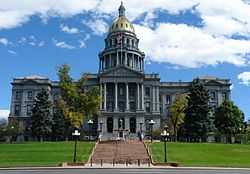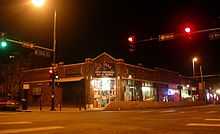Capitol Hill (Denver)

Located in the City and County of Denver, Colorado, the Capitol Hill neighborhood is bounded by Broadway, Downing Street, Colfax Avenue, and Seventh Avenue,[1] which carry large volumes of traffic around the neighborhood. It is technically located in East Denver which begins immediately east of Broadway, the neighborhood's western boundary. Many consider the Cheesman Park neighborhood to be a part of the Capitol Hill neighborhood, but as defined by the city , Cheesman Park is a separate neighborhood. Denver also recognizes a statistical neighborhood called North Capitol Hill, but this is called Uptown by many residents. Colfax Avenue is the border between these two neighborhoods.
Geography

The neighborhood is located just southeast of Denver's Central Business District (CBD) in a well-established residential neighborhood, with commercial centers located along major traffic routes (such as Colfax Avenue and Broadway) and interior arterials (such as East 13th and 14th Avenues). The neighborhood is directly east of the Civic Center neighborhood and the Colorado State Capitol. Over 95% of this neighborhood is developed. The average year of construction for buildings is 1920, with some of the oldest single-family homes in the city. The characteristics of Capitol Hill are closely related to other east Denver neighborhoods, which include the hospital district and the North Capitol Hill neighborhood. Public transportation and city support services are readily available. Neighborhood Boundaries:
- North - Colfax Avenue
- South - Seventh Avenue
- East - Downing Street
- West - Broadway
Characteristics
Capitol Hill is Denver's most densely populated neighborhood. It was once the home of Denver's elite and origination of American Foursquare architecture. Today it consists of historic mansions, apartments and condo buildings. Because of the concentration of multi-family uses and the urban character of the neighborhood, parking is at a premium. The area is strongly influenced by the Colorado State Capitol and Downtown Denver which is adjacent to the northwest boundary of the neighborhood. Commercial uses are typically located on major arterials such as Colfax Avenue, East 8th Avenue, East 14th Avenue, East 13th Avenue, Lincoln Street and Broadway. A considerable number of mansion properties have been converted to office uses over the past several years due to zoning exemptions offered to historic structures which are zoned for residential uses. Office development in the neighborhood is primarily concentrated in the northwest portion of the neighborhood with small professional offices located throughout the neighborhood.
Culture
The Capitol Hill neighborhood is influenced by its proximity to the Colorado State Capitol, Downtown and its northern boundary, East Colfax Avenue.
Capitol Hill is one of the most cosmopolitan neighborhoods in Denver, well known as a haven for artists and bohemians. There are numerous restaurants, clubs, bars, stores, concert venues, and other cultural amenities in the community. East 13th Avenue is the center of Denver's punk community with various stores that cater to punks and hipsters. Colfax Avenue has a reputation for a wild nightlife with two concert venues (The Fillmore and the Ogden), and numerous late-night bars, coffeeshops, restaurants, stores and clubs on the street. During the day, lobbyists and politicians from the Colorado State Capitol can be seen making deals in the restaurants and bars of the neighborhood.
Capitol Hill is also known as a gay-friendly neighborhood and is sometimes categorized as a gay village. The annual PrideFest gay pride parade goes through the neighborhood.
Capitol Hill is next to two major Denver parks, Civic Center Park and Cheesman Park. Both of these are meeting centers for the community; they host many festivals, including the Capitol Hill United Neighborhoods-sponsored People's Fair in early June.
Capitol Hill has had a long bohemiam reputation with the Colburn Hotel on Grant Street being a one time residence of Jack Kerouac and Allen Ginsburg.
Notable spots in Capitol Hill
- Wax Trax Records - record store opened in 1978 which spawned Wax Trax Records in Chicago. Located at 13th and Washington
- Quizno's subs - the first[citation needed] of the chain - 13th and Grant since 1981
- Molly Brown House - now a museum
Urban Renewal
Capitol Hill is one of many neighborhoods in central Denver in a gentrification phase. The neighborhood was originally the home of Denver's elite who constructed elaborate mansions. As the economy of Denver slumped after the Silver Crash of 1893, construction in Capitol Hill concentrated on apartments. Three buildings still in existence are examples of the architecture of this time: The Colonnade, Alta Court (currently an office building), and the Hamilton. This cultural and demographic shift, from single-family mansions toward boarding houses and rental property for the transient middle class, marked a shift toward the present multi-family dominance of the neighborhood.
Capitol Hill remained a solid middle-class neighborhood until after World War II, when middle-class families left Capitol Hill. The demographics of people left behind were transients and renters.
Another watershed in the history of Capitol hill was the completion of Interstate 70. No longer did incoming tourists drive down East Colfax Avenue on their way into downtown. The tourist dollar was effectively wiped out as a revenue source for East Colfax after this decade. So began another downward spiral. With no tourists to spend money along East Colfax the businesses suffered, as did the demand to go to Capitol Hill.
The affordability, urban character and eclectic architecture made the area appealing to young bohemians, artists, musicians (Jack Kerouac and Allen Ginsberg were former neighborhood residents) which has led to a gradual gentrification that reached its height during the 2000s. The rents in the neighborhood have increased significantly over the past decade, and many of the cheap apartments in the area have been converted into more expensive condominiums. Nonetheless the neighborhood has an older housing stock which lacks off-street parking, contributing to a relative affordability compared to other central neighborhoods.
Currently many portions of East Colfax Avenue are undergoing redevelopment to make them denser and more pedestrian-friendly. Despite these redevelopment efforts, a brief stroll along Colfax Avenue through the Capitol Hill neighborhood will provide a glimpse of its history.
Crime
Finally, Capitol Hill is also well known for its crime, particularly the sale and common use of drugs in the neighborhood. Recently drug sales have decreased in the neighborhood as policing initiatives brought down the crime rate and hastened the ongoing gentrification. The crime rate in the Capitol Hill neighborhood is at 114 incidents per 1,000 persons, well above the national and city averages.[2]
Gallery
-

Grant and 7th, near Gov's Park in Capitol Hill
-

13th and Pearl, in the heart of Capitol Hill
-
Wax Trax, 13th and Washington
-

Capitol Building, East edge
References
- ↑ "Official Neighborhood Boundaries". Denver.gov. Retrieved 2009-05-19.
- ↑ http://www.piton.org/index.cfm?fuseaction=CommunityFacts.Summary&Neighborhood_ID=868#Crime And Safety
Coordinates: 39°44′N 104°59′W / 39.733°N 104.983°W
